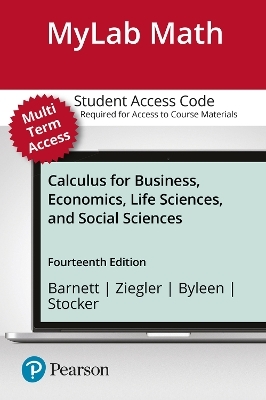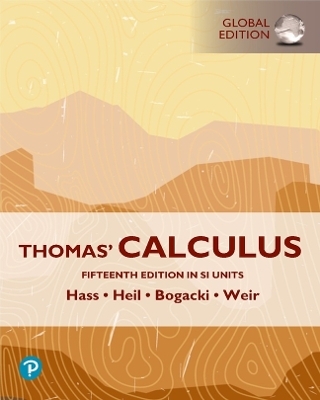
MyLab Math with Pearson eText Access Code (24 Months) for Calculus for Business, Economics, Life Sciences, and Social Sciences
Pearson (Hersteller)
978-0-13-485679-7 (ISBN)
- Titel z.Zt. nicht lieferbar
- Versandkostenfrei innerhalb Deutschlands
- Auch auf Rechnung
- Verfügbarkeit in der Filiale vor Ort prüfen
- Artikel merken
The 14th Edition features a brand-new, full-color redesign and updated layout to help you navigate more easily as you put in the work to learn the math. Throughout, data is updated in examples and exercises. New features include Reminder margin notes; all graphing calculator screens are updated to the TI-84 Plus CD; and much more.
Personalize learning with MyLab Math with Pearson+ eTextbook This flexible digital platform combines unrivaled content, online assessments and customizable features to personalize learning and improve results.
Pearson+ eTextbook is an easy-to-use digital textbook available within MyLab® that lets you read, highlight and take notes, all in one place.
NOTE: Before purchasing, check with your instructor to confirm the correct ISBN. Several versions of the MyLab and Mastering® platforms exist for each title, and registrations are not transferable. To register for and use MyLab, you will need either a course ID from your instructor or an invitation link that your instructor will send you directly.
Used books, rentals, and purchases made outside of Pearson If purchasing or renting from companies other than Pearson, the access codes for the MyLab platform may not be included, may be incorrect, or may be previously redeemed. Check with the seller before completing your purchase.
About our authors Raymond A. Barnett, a native of California, received his B.A. in mathematical statistics from the University of California at Berkeley and his M.A. in mathematics from the University of Southern California. He has been a member of the Merritt College Mathematics Department, and was chairman of the department for 4 years. Raymond Barnett has authored or co-authored 18 textbooks in mathematics, most of which are still in use. In addition to international English editions, a number of books have been translated into Spanish. The late Michael R. Ziegler received his B.S. from Shippensburg State College and his M.S. and Ph.D. from the University of Delaware. After completing postdoctoral work at the University of Kentucky, he was appointed to the faculty of Marquette University where he held the rank of Professor in the Department of Mathematics, Statistics and Computer Science. Dr. Ziegler published over a dozen research articles in complex analysis and co-authored 11 undergraduate mathematics textbooks with Raymond A. Barnett, and more recently, Karl E. Byleen. Karl E. Byleen received his B.S., M.A. and Ph.D. degrees in mathematics from the University of Nebraska. He is currently an Associate Professor in the Department of Mathematics, Statistics and Computer Science of Marquette University. He has published a dozen research articles on the algebraic theory of semigroups. Christopher J. Stocker received his B.S. in mathematics and computer science from St. John's University in Minnesota and his M.A. and Ph.D. degrees in mathematics from the University of Illinois in Urbana-Champaign. He is currently an Adjunct Assistant Professor in the Department of Mathematics, Statistics, and Computer Science of Marquette University. He has published 8 research articles in the areas of graph theory and combinatorics.
Table of Contents
Preface
Diagnostic Prerequisite Test
Functions and Graphs
1.1 Functions
1.2 Elementary Functions: Graphs and Transformations
1.3 Linear and Quadratic Functions
1.4 Polynomial and Rational Functions
1.5 Exponential Functions
1.6 Logarithmic Functions
Chapter 1 Summary and Review
Review Exercises
Limits and the Derivative
2.1 Introduction to Limits
2.2 Infinite Limits and Limits at Infinity
2.3 Continuity
2.4 The Derivative
2.5 Basic Differentiation Properties
2.6 Differentials
2.7 Marginal Analysis in Business and Economics
Chapter 2 Summary and Review
Review Exercises
Additional Derivative Topics
3.1 The Constant e and Continuous Compound Interest
3.2 Derivatives of Exponential and Logarithmic Functions
3.3 Derivatives of Products and Quotients
3.4 The Chain Rule
3.5 Implicit Differentiation
3.6 Related Rates
3.7 Elasticity of Demand
Chapter 3 Summary and Review
Review Exercises
Graphing and Optimization
4.1 First Derivative and Graphs
4.2 Second Derivative and Graphs
4.3 L’Hôpital’s Rule
4.4 Curve-Sketching Techniques
4.5 Absolute Maxima and Minima
4.6 Optimization
Chapter 4 Summary and Review
Review Exercises
Integration
5.1 Antiderivatives and Indefinite Integrals
5.2 Integration by Substitution
5.3 Differential Equations; Growth and Decay
5.4 The Definite Integral
5.5 The Fundamental Theorem of Calculus
Chapter 5 Summary and Review
Review Exercises
Additional Integration Topics
6.1 Area Between Curves
6.2 Applications in Business and Economics
6.3 Integration by Parts
6.4 Other Integration Methods
Chapter 6 Summary and Review
Review Exercises
Multivariable Calculus
7.1 Functions of Several Variables
7.2 Partial Derivatives
7.3 Maxima and Minima
7.4 Maxima and Minima Using Lagrange Multipliers
7.5 Method of Least Squares
7.6 Double Integrals over Rectangular Regions
7.7 Double Integrals over More General Regions
Chapter 7 Summary and Review
Review Exercises
Trigonometric Functions
8.1 Right Triangle Trigonometry
8.2 Trigonometric Functions
8.3 Derivatives of Trigonometric Functions
8.4 Integration of Trigonometric Functions
Chapter 8 Summary and Review
Review Exercises
Differential Equations
9.1 Basic Concepts
9.2 Separation of Variables
9.3 First-Order Linear Differential Equations
Chapter 9 Summary and Review
Review Exercises
Taylor Polynomials and Infinite Series
10.1 Taylor Polynomials
10.2 Taylor Series
10.3 Operations on Taylor Series
10.4 Approximations Using Taylor Series
Chapter 10 Summary and Review
Review Exercises
Probability and Calculus
11.1 Improper Integrals
11.2 Continuous Random Variables
11.3 Expected Value, Standard Deviation, and Median
11.4 Special Probability Distributions
Chapter 11 Summary and Review
Review Exercises
Appendix A: Basic Algebra Review
A.1 Real Numbers
A.2 Operations on Polynomials
A.3 Factoring Polynomials
A.4 Operations on Rational Expressions
A.5 Integer Exponents and Scientific Notation
A.6 Rational Exponents and Radicals
A.7 Quadratic Equations
Appendix B: Special Topics (online at goo.gl/mjbXrG)
B.1 Sequences, Series, and Summation Notation
B.2 Arithmetic and Geometric Sequences
B.3 Binomial Theorem
B.4 Interpolating Polynomials and Divided Differences
Appendix C: Integration Using Tables Answers Index Index of Applications
| Sprache | englisch |
|---|---|
| Maße | 151 x 226 mm |
| Gewicht | 20 g |
| Themenwelt | Mathematik / Informatik ► Mathematik ► Analysis |
| ISBN-10 | 0-13-485679-1 / 0134856791 |
| ISBN-13 | 978-0-13-485679-7 / 9780134856797 |
| Zustand | Neuware |
| Haben Sie eine Frage zum Produkt? |
aus dem Bereich

